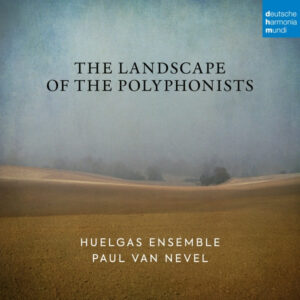Program: #23-03 Air Date: Jan 16, 2023
To listen to this show, you must first LOG IN. If you have already logged in, but you are still seeing this message, please SUBSCRIBE or UPGRADE your subscriber level today.
In honor of the 50th anniversary of their founding, the Huelgas Ensemble released a recording of composers familiar like Josquin and Gombert, and rare (Baston, Hasprois, and Celliers de Hesdin!).
NOTE: All of the music on this program comes from recording The Landscape of the Polyphonists featuring the Huelgas Ensemble directed by Paul van Nevel. It is in the Deutsche Harmonia Mundi label and is CD 19439955002.
Why did the polyphonists all come from the same region of southwest Belgium and northern France? And and what was the influence of this region on their music?
A unique analysis of the environment - the ‘cultural landscape’ - of the 15th and 16th century musician. In 2018, Paul Van Nevel wrote a book - ‘The Landscape of the Polyphonists’ - about these more than two hundred composers who, for more than one hundred and fifty years, left their mark on the style of vocal polyphony across the continent of Europe. Their style is based on two structures: the technique of imitation; and melody that is bathed in a haze of melancholy. In his book, Van Nevel defends the hypothesis that the Franco-Flemish landscape, with its gentle slopes, its omnipresent horizon, and its never-ending and visible seasonal changes, has left an indelible emotional impression on the children who, between the ages of six and ten, left the safe havens of this landscape and explored beyond their horizons for the first time, entering the colleges and cathedral singing schools of Cambrai, Douai, Arras and elsewhere. Often these children never returned to their birthplaces and became singers and composers at the musical centres of Europe, such as the Burgundian Court, the Habsburg courts and the Sistine Chapel.
This recording is a representation of the Franco-Flemish School in all its varied aspects and links them to images of the regions in which these composers spent their childhood. Repetitions in the landscape (the imitations) and the melancholy of expectation, lying beyond the horizon, are never far away.
From BBC Classical Music:
Paul van Nevel has been recording medieval music since 1971. This, his latest project, seems to have two purposes: to give a potted account of the development of Franco-Flemish polyphony c1400-c1550, and to show how the landscape of the local areas from which the composers came is embodied in their music.
The earliest composer here is Johannes Hasprois, who died c1428. His ‘Ma douce amour’ is an intricate work and the resonant acoustic does not help the texture, nor does the slightly lax approach to rhythm. The group is more at home in later pieces such as l’Héritier’s motet ‘Locutus est Dominus’ (c1552) the clamorous sounds of which they bring to a captivating conclusion.The landscape angle is slightly odd. We are not talking here about how the sounds of a landscape might be replicated (babbling brooks, birdsong etc), or its musical associations quoted (folksong etc), or even how a composer’s emotional attachment might be expressed. Rather (according to van Nevel) the landscape itself replicates ‘the spirit of its culture in a powerful way’. Hence Baston’s ‘Ung souvenir’ embodies ‘misty Artois’ (though the lines are sung with great clarity), Gombert’s ‘O malheureuse journée’ reflects the desolation of the Lele Valley (though it is performed rather stolidly), and Ockeghem’s Sanctus is actually modeled in part on a work by Dufay who grew up elsewhere. Luckily some real landscaping can be heard in Hesdin’s motet ‘Parasti’ where the performers shape the form and contour the dynamics splendidly.
- Johannes Symonis Hasprois (Haspres ca.1360 - Rome 1428): Ma douce amour (virelai à 3)
- Antoine Busnois (Busnes ca.1430 - Brugge 1492): Bel Acueil (rondeau à 1, 2 & 3)
- Johannes Ockeghem (St. Ghislain ca.1420 - Tours 1497): Sanctus 'Missa Caput' à 4
- Josquin Desprez (St. Sauveur (?) ca.1455 - Condé-sur-l'Escaut 1521): Cueur langoreulx (chanson à 5)
- Josquin Desprez: Agnus Dei 'Missa Malheur me bat' à 4, 2 & 6
- Antoine de Févin (Atrecht ca.1470 - Blois ca.1511): Lamentations pour le Jeudi Saint, Lectio Primo à 4
- Jean Mouton (Samer ca.1459 - St. Quentin 1522): Qui ne regrettoit le gentil Févin (lamento à 4)
- Nicolle des Celliers de Hesdin (Hesdin ca.1490 - Beauvais 1538): Parasti in dulcedine tua (motet à 5)
- Jean l'Héritier (Bisdom Teerenburg ca.1480 - Avignon ca.1552): Locutus est Dominus (motet à 9)
- Josquin Baston (Artois ca.1495 - ca.1550): Une souvenir me conforte (chanson à 5)
- Pierre de Manchicourt (Béthune ca.1510 - Madrid 1564): Agnus Dei 'Missa Veni Sancte Spiritus' à 6
- Nicolas Gombert (La Gorgue ca.1495 - Tournai ca.1560): O malheureuse journée (chanson à 5)
- Nicolas Gombert: Agnus Dei 'Missa Tempore paschali' à 6 & 12
Composer Info
Johannes Symonis Hasprois (ca.1360-1428), Antoine Busnois (ca.1430-1492), Johannes Ockeghem (1420-1497), Josquin Desprez (1455-1521), Antoine de Févin (1470-1511), Jean Mouton (1459-1522) , Nicolle des Celliers de Hesdin (1490-1538), Jean l'Héritier (1480-1552), Josquin Baston (1495-1550), Pierre de Manchicourt (1510-1564), Nicolas Gombert (1495-1560)
CD Info
Deutsche Harmonia Mundi CD 19439955002
